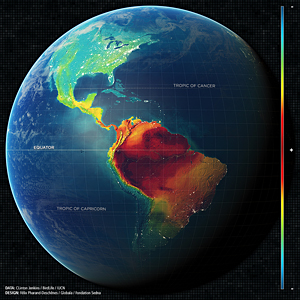In stunning color, new biodiversity research from North Carolina State University maps out priority areas worldwide that hold the key to protecting vulnerable species and focusing conservation efforts.
The research, published online in Proceedings of the National Academy of Sciences, pinpoints the highest global concentrations of mammals, amphibians and birds on a scale that’s 100 times finer than previous assessments. The findings can be used to make the most of available conservation resources, said Dr. Clinton Jenkins, lead author and research scholar at NC State University.
“We must know where individual species live, which ones are vulnerable, and where human actions threaten them,” Jenkins said. “We have better data than in the past—and better analytical methods. Now we have married them for conservation purposes.”

A global view showing combined species richness of amphibians, birds and mammals in the Americas. The species diversity layer is overlain on topography, superimposed by major cities in white. Data from Clinton Jenkins, BirdLife and IUCN. Illustration design by Félix Pharand-Deschênes (Globaïa).
To assess how well the bright-red priority areas are being protected, researchers calculated the percentage of priority areas that fell within existing protected zones. They produced colorful maps that offer a snapshot of worldwide efforts to protect vertebrate species and preserve biodiversity. More maps are available in high resolution on the Saving Species blog.
“The most important biodiversity areas do have a higher rate of protection than the global average. Unfortunately, it is still insufficient given how important these areas are,” said co-author Dr. Lucas Joppa with Microsoft Research in Cambridge, England. “There is a growing worry that we are running out of time to expand the global network of protected areas.”
Researchers hope their work can guide expansion of protected areas before it’s too late.
“The choice of which areas in the world receive protection will ultimately decide which species survive and which go extinct,” says co-author Dr. Stuart Pimm of Duke University. “We need the best available science to guide these decisions.”
Jenkins’ work was supported by the Gordon and Betty Moore Foundation, the Blue Moon Foundation and a National Aeronautics and Space Agency Biodiversity Grant.
*Source: North Carolina State University
